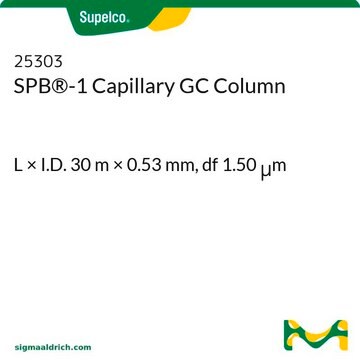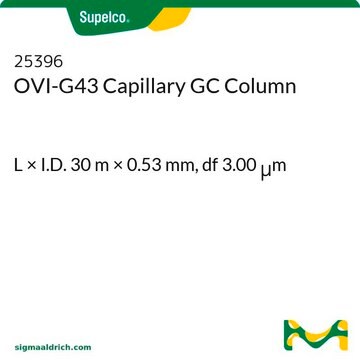24205-U
Colonne capillaire pour la GC VOCOL®
L × I.D. 30 m × 0.25 mm, df 1.50 μm
Synonyme(s) :
FS CAP VOCOL 30 M 0,25 MM 1,5 UM®
About This Item
Produits recommandés
Matériaux
fused silica
Agence
EPA TO-17,502.2,624,8015,8260,OLM04.2 VOA,524.2
NIOSH 1003
suitable for EPA 601
Paramètres
≤25-250 °C temperature (isothermal or programmed)
Valeur bêta
42
df
1.50 μm
Technique(s)
gas chromatography (GC): suitable
L × D.I.
30 m × 0.25 mm
Application(s)
environmental
food and beverages
forensics and toxicology
industrial hygiene
Type de colonne
capillary intermediate polar
Vous recherchez des produits similaires ? Visite Guide de comparaison des produits
Catégories apparentées
Description générale
Code USP : Aucun
Phase :
- greffée
- Déposée
- ≤0,32 mm D.I., <2 μm : De sub-ambiante à 250 °C (isotherme ou programmée)
- ≤0,32 mm D.I., ≥2 μm : De sub-ambiante à 230 °C (isotherme ou programmée)
- ≥0,53 mm D.I., <2 μm : De sub-ambiante à 250 °C (isotherme ou programmée)
- ≥0,53 mm D.I., ≥2 μm : De sub-ambiante à 230 °C (isotherme ou programmée)
Application
Autres remarques
Informations légales
Faites votre choix parmi les versions les plus récentes :
Déjà en possession de ce produit ?
Retrouvez la documentation relative aux produits que vous avez récemment achetés dans la Bibliothèque de documents.
Les clients ont également consulté
Articles
HS-SPME with Carboxen®/PDMS coated Nitinol fiber allows low MW analyte detection in light-exposed milk plastics.
HS-SPME with Carboxen®/PDMS coated Nitinol fiber allows low MW analyte detection in light-exposed milk plastics.
HS-SPME with Carboxen®/PDMS coated Nitinol fiber allows low MW analyte detection in light-exposed milk plastics.
HS-SPME with Carboxen®/PDMS coated Nitinol fiber allows low MW analyte detection in light-exposed milk plastics.
Protocoles
In this article, SPME-GC was successfully used to identify many volatile compounds present in the headspace over several spirits.
There are three types of analyses: GRO, DRO, and TPH. The published methods are simply variations of these to meet the different analytical needs of the individual agencies.
There are three types of analyses: GRO, DRO, and TPH. The published methods are simply variations of these to meet the different analytical needs of the individual agencies.
There are three types of analyses: GRO, DRO, and TPH. The published methods are simply variations of these to meet the different analytical needs of the individual agencies.
Contenu apparenté
This page is intended to make it easier to find the consumables you need based on the analytical method you’re using. Methods included on this page come from the EPA, Standard Methods and ASTM.
Chromatograms
suitable for GCsuitable for GC, application for SPMEsuitable for GC, application for SPMEsuitable for GCNotre équipe de scientifiques dispose d'une expérience dans tous les secteurs de la recherche, notamment en sciences de la vie, science des matériaux, synthèse chimique, chromatographie, analyse et dans de nombreux autres domaines..
Contacter notre Service technique











